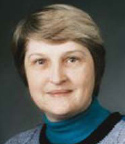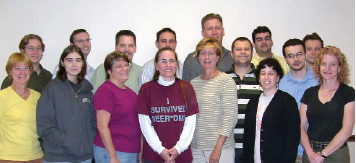Cancer Control and Population Sciences Home
About Surveillance Research:
Surveillance Research Program Bulletin–Fall 2006
Web sites: surveillance.cancer.gov; srab.cancer.gov ; seer.cancer.gov
; seer.cancer.gov
Contents
Mission Statement
The Surveillance Research Program (SRP) directs the collection and analysis of pertinent data in order to answer key questions about cancer incidence, morbidity, mortality, and cancer-related health status in diverse regions and populations in the United States. As part of the SRP mission, the Cancer Statistics Branch manages the Surveillance, Epidemiology, and End Results (SEER) Program, an integrated, comprehensive, multiple population-based cancer registry system authorized by the National Cancer Act of 1971.
SRP also provides leadership, through its Statistical Research and Applications Branch, in developing statistical methodologies appropriate for analyzing trends and for evaluating the impact of cancer control interventions as well as geographic, social, behavioral, genetic, and health care delivery factors on the cancer burden.
An authoritative source of information on cancer incidence and survival, SEER currently collects and publishes data covering approximately 26 percent of the U.S. population. Established in 1973, the SEER Program provides the greatest longevity and highest level of standardization for population-based cancer information in the United States.
- Highlights
- Funding Opportunities
- Employment Opportunities
- Training Opportunities
- SRP Staff News
- New SRP Publications
- SEER Registry Staff News
- SEER Registry Staff Profile
- New SEER Publications
- CISNET Staff Profile
- New CISNET Publications
- SEER Public-Use Data Files
- SEER Analytic Tools
- Surveillance Research Program Staff
Highlights
Most Recent Data Release
County Attribute Variables
New in 2006, SEER*Stat includes county-level attribute variables that are linked to SEER incidence, U.S. mortality, and U.S. population data. This new feature enables users to compute cancer rates and frequency distributions stratified by sociodemographic variables that characterize the county of residence for each cancer case record. Variables related to educational attainment, employment, income, foreign place of birth, migration, and poverty status are among those now available. A more detailed description of the county attribute variables may be found at http://seer.cancer.gov/seerstat/variables/countyattribs/ .
.
New Monographs
Cancer Epidemiology in Adolescents and Young Adults

This monograph is the first treatise to collect detailed information exclusively on cancer incidence and outcomes in adolescents and young adults (AYA) 15-29 years of age. It was developed to gather population-based incidence, mortality, and survival data specific to cancers that occur in the AYA population. Each chapter is disease specific. The monograph seeks to educate medical providers and the public concerning cancer incidence and survival in this age group and to provide the impetus for further research in hopes of improving survival and the quality of life of these young people.
Bleyer A, O'Leary M, Barr R, Ries LAG (eds). Cancer Epidemiology in Older Adolescents and Young Adults 15 to 29 Years of Age, Including SEER Incidence and Survival: 1975-2000. National Cancer Institute, NIH Pub. No. 06-5767. Bethesda, MD 2006.
Available online at http://seer.cancer.gov/publications , or a printed copy may be requested at 1-800-4-CANCER.
, or a printed copy may be requested at 1-800-4-CANCER.
Middle East Cancer Consortium Monograph

This monograph compiles information on cancer incidence between 1996 and 2001, drawn from cancer registries in four of the member countries (Cyprus, Egypt, Israel, and Jordan), as part of the Joint Cancer Registration Project of the Middle East Cancer Consortium (MECC). The primary goal of MECC, established in 1996, is to reduce the incidence and impact of cancer in the Middle East through collaborative research. The monograph marks the first comprehensive publication of the MECC Cancer Registration Project and includes information on the study population, how data were collected, data interpretation, and data strengths and limitations.
Freeman LS, Edwards BK, Ries LAG, Young JL (eds). Cancer Incidence in Four Member Countries (Cyprus, Egypt, Israel, and Jordan) of the Middle East Cancer Consortium (MECC) Compared with U.S. SEER. National Cancer Institute. NIH Pub. No. 06-5873. Bethesda, MD 2006.
Available at the SEER Web site at http://seer.cancer.gov/publications and on the MECC Web site at http://mecc.cancer.gov
and on the MECC Web site at http://mecc.cancer.gov , under Cancer Registry Project.
, under Cancer Registry Project.
Methods for Measuring Cancer Disparities Monograph

This report raises conceptual issues concerning the overall Healthy People 2010 goals of increasing the span of healthy life and eliminating health disparities across the categories of gender, race or ethnicity, education or income, and geographic location. It provides an innovative methodologic approach germane to measuring progress toward the goal of eliminating health disparities. The report recommends a sequence of steps to measure and monitor health disparities trends, using a suite of indicators and measurement strategies, and discusses the strengths and weaknesses of each.
Harper S, Lynch J. Methods for Measuring Cancer Disparities: Using Data Relevant to Healthy People 2010 Cancer-Related Objectives. NCI Cancer Surveillance Monograph Series, Number 6. National Cancer Institute. NIH Pub. No. 05-5777. Bethesda, MD 2005.
Available at http://seer.cancer.gov/publications/disparities .
.
Funding Opportunities Sponsored by SRP
Biostatistics Funding
The Surveillance Research Program's funded grants portfolio is available at http://statfund.cancer.gov . This Web site is managed by Ram Tiwari, Ph.D., a Program Director and Mathematical Statistician in the Statistical Research and Applications Branch. The portfolio consists of approximately 100 funded projects in biometry and biostatistics. Statistical methods in this portfolio allow for the interpretation of research results across the full spectrum of the cancer control continuum. Established for the extramural statistical research community, statfund.cancer.gov
. This Web site is managed by Ram Tiwari, Ph.D., a Program Director and Mathematical Statistician in the Statistical Research and Applications Branch. The portfolio consists of approximately 100 funded projects in biometry and biostatistics. Statistical methods in this portfolio allow for the interpretation of research results across the full spectrum of the cancer control continuum. Established for the extramural statistical research community, statfund.cancer.gov brings together in one place much of the relevant information about National Institutes of Health (NIH) funding mechanisms and opportunities in the field of biostatistics.
brings together in one place much of the relevant information about National Institutes of Health (NIH) funding mechanisms and opportunities in the field of biostatistics.
Small Business Innovation Research Opportunities
Opportunities in Small Business Innovative Research (SBIR) include (1) Development of Software Systems to Facilitate the Use of Electronic Data Records in the Collection of Population-Based Cancer Surveillance Data, and (2) Develop Automated Methods to Identify Environmental Exposure Patterns in Satellite Imagery Data. Announcements are available at http://grants1.nih.gov/grants/funding/sbircontract/phs2007-1.pdf, numbers 233 and 234.
Employment Opportunities
The Surveillance Research Program currently has a number of positions available. The positions encompass several areas of responsibility: (1) developing new analytic approaches and methods to estimate and present statistics that contribute to the understanding and interpretation of cancer data, including developing software associated with these new statistical methodologies; (2) conducting research to answer key questions about cancer rates, risk factors (including genetic risk factors), outcomes, and cancer-related health status in diverse U.S. populations; (3) initiating and managing collaborative analyses of SEER data and the rich data sets that result from database linkages such as SEER and the National Longitudinal Mortality Study; and (4) developing geographic information systems that apply visualization techniques to geospatial data to expand insight into cancer statistics, particularly patterns of cancer incidence, mortality, and survival.
Each position includes responsibility for initiating and managing collaborative analyses with scientists from NCI and other institutes, agencies, and academic centers. Current openings include:
- Chief, Cancer Statistics Branch (considerable postdoctoral experience required)
- Senior Mathematical Statistician (requires a minimum of 4 years of postdoctoral experience)
- Biostatistician (requires a minimum of 2 years of postdoctoral experience)
A doctoral degree is required for all positions. Excellent communication and interpersonal skills also are essential. The salary will be commensurate with experience. The positions are located in Rockville, MD, near Washington, DC, and include excellent benefits. U.S. citizenship or permanent residency is required for federal positions. The U.S. Department of Health and Human Services (DHHS) and NIH are equal opportunity employers. Please send a cover letter that briefly summarizes your experience and interests along with your Curriculum Vitae, preferably by e-mail, by November 30, 2006, to:
Judith Swan, MHS
Surveillance Research Program, DCCPS
E-mail: js60y@nih.gov
http://surveillance.cancer.gov/
http://seer.cancer.gov/
http://srab.cancer.gov/
Training Opportunities
Principles of Oncology Training Program
A. Fritz and Associates is holding a concentrated 5-day training program in cancer registry operations and procedures entitled, "Principles of Oncology for Cancer Registry Professionals." The program will emphasize accurate data collection methods and will include extensive, site-specific, hands-on case coding, abstracting, and staging sessions using practice cases that are representative of the many situations registrars may face. The course will be held December 4-8, 2006, in Reno, Nevada, and is endorsed by the National Cancer Registrars Association (NCRA) and the North American Association of Central Cancer Registries (NAACCR). The registration fee is $895, and all workshop materials will be provided. This program is currently full and operating on a waiting list; however, additional training programs on the topic are being scheduled for the upcoming year.
For additional course information, prerequisites, and registration materials, please visit http://www.afritz.org/courses.htm.
Quantitative Methods in Cancer Surveillance Course Well Received
The Statistical Research and Applications Branch (SRAB) recently coordinated a course entitled "Quantitative Methods in Cancer Surveillance" at the Summer Institute of Epidemiology and Biostatistics, offered through the Johns Hopkins Bloomberg School of Public Health. This 5-day course, held June 26-30, 2006, provided students with skills needed to understand and implement statistical methods used in cancer surveillance. More than 40 individuals attended from a variety of backgrounds, including cancer registrars, researchers, and oncologists. For future course offerings, see the SRAB Web site at http://srab.cancer.gov/ .
.
SRP Staff News
April Fritz Retires From SEER

April G. Fritz, Registered Health Information Technician and Certified Tumor Registrar, retired in the spring of 2006 from her position as Manager of Data Quality for the SEER Program after 10 years of employment at NCI. During her tenure, she aided in the development of numerous standard registry references in addition to tools for cancer registrars. She was responsible for the development of the Principles of Oncology for Cancer Registry Professionals training program in 1992.
A former president of the National Cancer Registrars Association (NCRA), Ms. Fritz received numerous professional honors, including the Distinguished Member and Education awards from the NCRA, the Distinguished Service Award from the North American Association of Central Cancer Registries, and service awards from NCI.
Following her retirement from NCI and relocation to Nevada, Ms. Fritz has formed her own cancer registry training and consulting company. Additionally, she recently was appointed Director of the Cancer Information Management Program at Santa Barbara City College in California.
Benjamin Hankey Retires From CSB

Benjamin F. Hankey, Sc.D., retired on June 30, 2006, after 38 years of NCI service. He spent his career at NCI working in various capacities as a mathematical statistician, most recently having served as Chief of the Cancer Statistics Branch (CSB) in the Surveillance Research Program since 1989. Under his management, the SEER program accomplished wider coverage, having expanded in several phases to cover from 11 to 26 percent of the U.S. population.
"Ben's leadership in the collection and analysis of high-quality cancer incidence data has been essential to the cancer research enterprise," said Dr. Robert Croyle, DCCPS Director.
Dr. Hankey first came to NCI in 1968 while still a graduate student at the University of Pittsburgh working toward his Sc.D. in Biostatistics. At this juncture, his research focused primarily on statistical methods for analyzing survival data and the analysis of data from clinical studies. His thesis focused on the association between stomach cancer and the consumption of various foods by Japanese migrants living in Hawaii to explain the changes in cancer risk observed in migrants as they became more Westernized. More recently, his research involved statistical methods for cancer surveillance, the interpretation of trends in cancer rates, and the creation of tools for integrating cancer surveillance data into the cancer control planning process.
Dr. Hankey departs NCI with an impressive history of accomplishments, including having received the NIH Merit Award (1993) and the prestigious NIH Director's Award (1998). Dr. Hankey also served as a reviewer for numerous scientific journals, including the Journal of the National Cancer Institute, Cancer, Journal of Chronic Diseases, Biometrics, Preventive Medicine, and Cancer Causes and Control.
In retirement, Dr. Hankey will continue his research in collaboration with Dr. Rocky Feuer and others to develop a tool to provide more meaningful information on patient prognosis to both clinicians and patients who use the SEER database.
Lin Clegg Moves to Veterans Affairs

Limin (Lin) Clegg, Ph.D., a mathematical statistician in SRP since 1997, recently accepted the position of Senior Mathematical Statistician in the Office of Healthcare Inspections in the U.S. Department of Veterans Affairs (VA). At the VA, Dr. Clegg will be working on projects that provide oversight and consultation to improve and strengthen VA health care programs that are essential to the well-being of veteran patients.
Dr. Clegg brought to SRP a theoretical approach to population-based cancer statistics evidenced in publications on such topics as reporting delay adjustment, cancer prevalence estimation, and survival analysis. She provided statistical consultation to many projects within SRP, DCCPS, and others. She oversaw numerous activities under the SEER Rapid Response Surveillance Study Program, the National Longitudinal Mortality Study (NLMS), and the SEER-NLMS Study. She also mentored Cancer Research Training Award fellows from the Harvard Biostatistics Department and MIT Mathematics Department.
In addition to other publications, Dr. Clegg has authored or coauthored more than 40 research articles published in peer-reviewed journals, including Biometrics, The Journal of the American Statistical Association, American Journal of Epidemiology, Journal of the National Cancer Institute, Journal of Clinical Oncology, and The New England Journal of Medicine. She was awarded the NIH Merit Award in 2001. She was also awarded the prestigious James E. Grizzle Distinguished Alumni Award in 2004 from the University of North Carolina at Chapel Hill, where she earned her Ph.D. in biostatistics.
Lynn Ries Elected to Position in IACR

Lynn Ann Gloeckler Ries, M.S., was elected in August 2006 to be the North American representative to the International Association of Cancer Registries (IACR). Founded in 1966, IACR is a professional society dedicated to promoting the goals and activities of cancer registries worldwide. IACR provides cancer statistics on five continents and has had official relations with the World Health Organization since January 1979.
Lynn Ries received a B.A. in mathematics from St. Joseph College and completed her master's degree in biomathematics at the University of Washington. Currently, she is a health statistician in NCI's Cancer Statistics Branch, where her areas of interest include childhood cancer, trends in incidence and mortality rates, cancer registry operations, and standards used in data collection. Ms. Ries also serves on numerous committees within the North American Association of Central Cancer Registries (NAACCR), including the Uniform Standards Committee, Information and Technology Committee, EDITS subcommittee, Standards Implementation Work Group, Real Time Reporting subcommittee, and the Volume II Work Group. Additionally, she serves on the Brain Tumor Program Review Group at NCI. She also co-authors the "Annual Report to the Nation on the Status of Cancer" and the Cancer Statistics Review.
Marsha Reichman Named Cancer Statistics Branch Acting Chief

Marsha E. Reichman, Ph.D., has been named Acting Chief of SRP's Cancer Statistics Branch. She is a biostatistician/epidemiologist who will provide leadership within the program through the coordination of data collection, data reporting and interpretation, and research activities. Prior to joining SRP in early 2003, she was the Director of the Epidemiology and Survey Research Unit at Northrop Grumman Information Technologies Solutions, where she provided technical oversight and direction on projects for numerous federal agencies, including the National Institute of Dental and Craniofacial Research, the Office of Women's Health, the U.S. Food and Drug Administration, and the DHHS Office of Research Integrity. She also has been a member of the Scientific Grants Review Panel at the Cancer Research Foundation of America since 1992.
Dr. Reichman has been involved in the development of the SEER registry data management system (SEER*DMS), research in cancer-related health disparities, cancer survival, biospecimen-related studies, and statistics for population groups. She is cochair of the DCCPS Health Informatics Steering Committee, NCI Liaison to the caBIG Population Sciences Special Interest Group, and is a member of the steering committee for the SEER/National Longitudinal Mortality Study (NLMS). Dr. Reichman holds a Ph.D. in cell and molecular biology from the Massachusetts Institute of Technology, an M.S. in mathematical statistics from the University of Maryland, and a B.A. in mathematics and biology from Barnard College.
Kathy Cronin Receives the NIH Director's Award

Kathy Cronin, Ph.D., a 2006 recipient of the NIH Director's Award, is a mathematical statistician in the Statistical Research and Applications Branch, SRP. This prestigious award recognizes the expert skills and efforts of NIH employees in scientific discovery management. Dr. Cronin has been a leader in the impact of cancer control interventions on population incidence and mortality and a principal in a study among investigators of NCI's Cancer Intervention and Surveillance Modeling Network (CISNET) to address the question of screening mammography and treatment effects on breast cancer mortality. Findings from this landmark study were published in the New England Journal of Medicine and resulted in a major contribution to public health practice.
Dr. Cronin received her master's degree in operations research from the George Washington University, her M.P.H. concentrating in epidemiology from Johns Hopkins University, and her Ph.D. in operations research from Cornell University. She also has been the recipient of the NIH Merit Award, given to researchers in recognition of superior competence and outstanding productivity in their research endeavors.
SEER*DMS Team Wins 2006 Merit Award

The SEER*DMS (data management system) team was awarded the 2006 NIH Merit Award for its leadership and outstanding effort in developing Database Management System software for cancer registries that participate in the SEER Program. Led by Dr. Marsha Reichman, the team includes the SRP's Carol Kosary, M.S., Lynn Ries, M.S., Steve Peace, B.A., C.T.R., and Peggy Adamo, R.H.I.T., C.T.R.; and, from Information Management Services, Inc. (IMS), Dave Annett, Chuck May, Nicki Schussler, Linda Coyle, Laurie Rich, Janis Beach, Jessica Lachewitz, Deb Hacker, Jennifer Kaplan, Andrew Lafollette, Manfred Heinemann, John Simpson, Michael Depry, Roger Cracel, Arianit Rukaj, Fabian Depry, and Scott Depuy. This prestigious award is presented annually to researchers who have demonstrated superior competence and productivity in their research endeavors.

The team developed SEER*DMS with extensive input from the 15 SEER cancer registries. It was implemented for the first time in 2005 at the Detroit Tumor Registry, at the Connecticut Tumor Registry in 2006, and is scheduled for implementation in two additional registries during the upcoming year. SEER*DMS provides a unified, modular approach to central cancer registry function and can be customized to individual registries, including modification of workflow. The system facilitates updating methods and algorithms for collecting and reporting data, provides cost-savings, and increases the efficiency of registry operations.
Grantee Award: Xihong Lin Awarded the 2006 Presidents' Award

Xihong Lin, Ph.D., a professor in the Department of Biostatistics at Harvard University and an SRP grantee, has been awarded the 2006 Presidents' Award from the Committee of Presidents of Statistical Societies (COPSS). This award is presented annually to a young statistician in recognition of his/her outstanding contribution to the statistics profession and is the most prestigious honor awarded by the COPSS. Dr. Lin's award citation referenced her methodological work in several areas, including longitudinal data analysis, survival analysis, and the analysis of measurement errors. In addition, she was recognized for her exceptional leadership in the training of young researchers in the field of biostatistics. Her methodological research has been sponsored by NCI since 1997, and she currently serves as Principal Investigator for three grants. Two of these grants are R13 multiyear conference grants: R13CA90250: ENAR Young Researcher Workshop; and R13CA124365: Conferences on Emerging Statistical Issues in Biometric Issues. The third grant covers 2R01CA76404-11: Statistical Methods for Correlated and High-Dimensional Biomedical Data. All of these grants are housed in SRP's biostatistical methodology grants portfolio, managed by Dr. Ram Tiwari.
New SRP Publications
Coughlin SS, Richards TB, Thompson T, Miller BA, Vaneenwyk J., Goodman MT, Sherman RL. Rural/nonrural differences in colorectal cancer incidence in the United States, 1998-2001. Cancer. 2006 Jun 26;107(S5):1181-8.
Fay MP, Tiwari RC, Feuer EJ, Zou Z. Estimating average annual percent change for disease rates without assuming constant change. Biometrics. 2006; 62:847-854. Gumpertz ML, Miller BA, Pickle LW, Bell SB. Geographic pat- terns of advanced breast cancer in Los Angeles: associations with biological and sociodemographic factors (United States). Cancer Causes Control. 2006;17:325-99.
Harlan LC, Clegg LX, Abrams J, Stevens JL, Ballard-Barba Community-based use of chemotherapy and hormonal therapy for early- stage breast cancer: 1987-2000. J Clin Oncol. 2006 Feb 20;24(6):872-7.
Mariotto AB, Wesley MN, Cronin KA, Johnson KA, Feuer EJ. Estimates of long-term survival for newly diagnosed cancer patients: a projection approach. Cancer. 2006 May 1;106(9): 2039-50.
Pickle L. Evaluating data with GIS and spatial statistical analyses. HealthyGIS. Summer 2006;1-3.
Swan J, Breen N, Burhansstipanov L, Satter DE, Davis WW, McNeel T, Snipp CM. Cancer screening and risk factor rates among American Indians. Am J Public Health. 2006 Feb;96(2):340-50. Yu B, Tiwari RC. Multiple imputation methods for modeling relative survival data. Stat Med. 2006;25:2946-2955.
SEER Registry Staff News
Bill Wright Retires; Rosemary Cress Appointed New PI
William E. Wright, Ph.D., stepped down in July as the SEER Principal Investigator (PI) for the Greater California Registry after 5 years. Taking over as PI for this registry is Rosemary D. Cress, Dr.P.H. Dr. Cress has been with the California Cancer Registry (CCR) since 1995 and has been a co-investigator with the SEER program since 2005. She has extensive experience working with both the NCI and CDC on research related to cancer surveillance and patterns of care.

Dr. Cress received her M.P.H. and Dr.P.H. in epidemiology from Tulane University. Her research interests include gynecologic cancers, colorectal cancer, quality of cancer care, and health disparities. She currently is assistant adjunct professor of Epidemiology at the University of California at Davis School of Medicine and is the Research Program Director of the Cancer Epidemiology Research Unit at the CCR/Public Health Institute (PHI). PHI is a nonprofit organization dedicated to promoting health, well-being, and quality of life for all through research and evaluation, training, and technical assistance, and to the forging of partnerships within California communities.
Sally Glaser To Be PI, With Cynthia O'Malley and Dee West As Co-Investigators

Sally L. Glaser, Ph.D., a Research Scientist at the Northern California Cancer Center and a Consulting Associate Professor in the Department of Health Research and Policy at Stanford University, has assumed the position as Principal Investigator (PI) and Director of the Greater Bay Area Cancer Registry. Dr. Glaser is an epidemiologist who received her M.S. and Ph.D. degrees from the University of California at Berkeley. In addition to the use of population-based surveillance data to understand cancer incidence and outcomes, her research interests include the etiology of Hodgkin lymphoma and breast cancer. Dr. Glaser came to the SEER program in 1991 with a focus on data usage and surveillance research and served as Director for Surveillance Research for many years.

Cynthia D. O'Malley, Ph.D., a Research Scientist at the Northern California Cancer Center and lecturer at Stanford University, serves as Co-Investigator and Deputy Director of the Greater Bay Area Cancer Registry. Dr. O'Malley earned her M.S. and Ph.D. degrees in epidemiology from the University of California at Berkeley and worked in the area of infectious diseases and immunization prior to coming to the Northern California Cancer Center and the SEER program in 1999. Her research interests in cancer epidemiology include ovarian and cervical cancer, surveillance research, and cancer outcomes, including the impact of comorbidity.

Dee W. West, Ph.D., previous PI and now Co-Investigator of the Greater Bay Area Cancer Registry, first became involved with SEER in 1979 as part of a bladder cancer study and went on to serve as PI in both the Utah and Northern California registries. He received his Ph.D. in medical sociology/epidemiology from the State University of New York at Buffalo. Currently, he serves on the Steering Committee for the State of California Cancer Control Plan and chairs the National Coordinating Council for Cancer Surveillance. He is Chief Scientific Officer for the Northern California Cancer Center, Professor in the Department of Health Research and Policy Epidemiology at Stanford University, and past president of the North American Association of Central Cancer Registries.
Betsy Kohler, President of NAACCR

Betsy A. Kohler, M.P.H., C.T.R., is president of the North American Association of Central Cancer Registries, Inc. (NAACCR). Established in 1987, NAACCR is a professional organization that includes all central cancer registries in the United States and Canada. The mission of the organization is to develop and promote uniform data standards for cancer registration; provide education and training; certify population-based registries; aggregate and publish data from central cancer registries; and promote the use of cancer surveillance data and systems for cancer control and epidemiologic research, public health programs, and patient care to reduce the burden of cancer in North America. In addition, Ms. Kohler has worked in cancer epidemiology for 25 years at the New Jersey Department of Health and Senior Services, serving as the Principal Investigator of the New Jersey State Cancer Registry and Director of Cancer Epidemiology Services.
Obituary: Ronald Ross

Ronald K. Ross, M.D., pioneering researcher on the relationship between hormones and cancer and chair of the renowned Department of Preventive Medicine at the University of Southern California's (USC) Keck School of Medicine, died of brain cancer April 21, 2006, at age 57.
Born in Muscatine, Iowa, Dr. Ross earned a bachelor's degree from Rutgers University and his master's and medical degrees in preventive medicine and environmental health from the University of Iowa in 1975. In 1976, Dr. Ross joined the USC faculty—in what was then known as the Department of Community and Family Medicine—and thus began his remarkable 30-year career. In 1987, he became director of the Los Angeles Cancer Surveillance Program, which became a SEER registry in 1992, and is noted for conducting population based studies and evaluating demographic patterns of cancer risk.
With more than 250 publications to his name, Dr. Ross was recognized as a leading authority on hormone-related cancers. He held the Catherine and Joseph Aresty Chair in Urologic Cancer, Flora L. Thornton Chair in Preventive Medicine, and was the top-funded faculty member at the Keck School of Medicine.
Dr. Ross is survived by his wife and their three children. The family requests that donations in his name go to the Dr. Ronald Ross Cancer Fund at the USC Norris Comprehensive Cancer Center, 1441 Eastlake Avenue, Room 8302, Los Angeles, CA 90033.
SEER Registry Staff Profile
Dennis Deapen, Dr.P.H., Director of the Cancer Surveillance Program, Los Angeles County

Dennis M. Deapen, Dr.P.H., current Principal Investigator of the Los Angeles SEER registry and Director since 2000, is also a professor of Preventive Medicine at the University of Southern California's Keck School of Medicine. Dr. Deapen has been involved with the Los Angeles County registry since 1988, and oversaw its transition to the SEER program in 1992. His expertise in the field of cancer surveillance is an invaluable asset to achieving the SEER program's goal of collecting complete and accurate data on all cancers diagnosed among residents of geographic areas covered by SEER cancer registries.
After earning his M.P.H. in epidemiology from Loma Linda University, Dr. Deapen received his Dr.P.H. in epidemiology from the University of California (USC), Los Angeles. He joined the staff at USC in 1977 and was appointed to the faculty in 1982. During his tenure at USC, he has been a pioneer in studying the health risks of breast implants. He also has been involved in the California Teachers Study, one of the largest cohort studies in the Nation. Using data from the California Cancer Registry since 1994, Dr. Deapen and colleagues have shown that teachers in California have been diagnosed with breast cancer at a disproportionately high rate compared to other groups with similar demographics. This study has demonstrated the value of population-based cancer registries in identifying disparities that are not limited by social strata. According to Dr. Deapen, "Even as surveillance data are used to reveal disparities, it serves to advance equality by leading to improvements in public health."
Recently, Dr. Deapen has been conducting innovative research in the field of cancer data acquisition on the potential underreporting of cancer incidence from nonhospital sources. One study, an NCI-funded special investigation, seeks to determine the number of cancer cases being diagnosed and treated in physicians' offices but omitted from cancer surveillance programs. This applies particularly to common cancers such as melanoma and early-stage breast and prostate cancers, which are being diagnosed with increasing frequency at the offices of the more than 25,000 Los Angeles County licensed physicians. Incidence rates have continued to increase for all of these cancers, and there is concern that—if the cancer surveillance system is in fact missing some of these cases—the magnitude of the problem is being underestimated. In the coming year, Dr. Deapen and his team will review patient records from dermatologists' and dermatolopathologists' offices to ascertain how many cases are occurring that are not being reported. Using these data, they will seek to establish procedures for a new surveillance—approach in the hopes of decreasing delays and missing reports to produce cancer incidence rates with increased accuracy.
In addition to his research in the field of cancer surveillance, Dr. Deapen has served the registry community through his involvement in numerous professional organizations. He was the President of the North American Association of Central Cancer Registries from 2003 to 2005 and was the North American Representative to the International Association of Cancer Registries from 2001 to 2006. Proud to be partnered with leading authorities on cancer registration, Dr. Deapen's vision for the future of cancer surveillance is bright. "From my perspective, people working in surveillance are unusually dedicated to their work and often go to great lengths to produce high-quality results," he explains. Dr. Deapen believes that this dedication translates into increased recognition within the research community of the importance of cancer surveillance in producing the highest quality data for epidemiological research.
Selected SEER Publications From Dr. Deapen's SEER Experience
Bernstein L, Patel AV, Ursin G, Sullivan-Halley J, Press MF, Deapen D, Berlin JA, Daling JR, McDonald JA, Norman SA, Malone KE, Strom BL, Liff J, Folger SG, Simon MS, Burkman RT, Marchbanks PA, Weiss LK, Spirtas R. Lifetime recreational exercise activity and breast cancer risk among black women and white women. J Natl Cancer Inst. 2005 Nov 16;97(22):1671-9.
Deapen, D. Cancer surveillance and information: balancing public health with privacy and confidentiality concerns (United States). Cancer Causes Control. 2006 Jun;17(5):633-7.
Morrow M, Mujahid M, Lantz PM, Janz NK, Fagerl Schwartz K, Liu L, Deapen D, Salem B, Lakhani I, Katz SJ. Correlates of breast reconstruction: results from a population-based study. Cancer. 2005 Dec 1;104(11):2340-6.
Janz NK, Mujahid M, Lantz PM, Fagerlin A, Salem B, Morrow M, Deapen D, Katz SJ. Population-based study of the relationship of treatment and sociodemographics on quality of life for early stage breast cancer. Qual Life Res. 2005 Aug;14(6):1467-79.
Katz SJ, Lantz PM, Janz NK, Fagerlin A, Schwartz K, Liu L, Deapen D, Salem B, Lakhani I, Morrow M. Patient involvement in surgery treatment decisions for breast cancer. J Clin Oncol. 2005 Aug 20;23(24):5526-33.
Katz SJ, Lantz PM, Janz NK, Fagerlin A, Schwartz K, Liu L, Deapen D, Salem B, Lakhani I, Morrow M. Patterns and correlates of local therapy for women with ductal carcinoma in-situ. J Clin Oncol. 2005 May 1;23(13):3001-7.
Simon MS, Mueller BA, Deapen D, Copeland G. A comparison of record linkage yield for health research using different variable sets. Breast Cancer Res Treat. 2005 Jan;89(2):107-10.
New SEER Publications
Ahmed F, Goodman MT, Kosary C, Ruiz B, Wu XC, Chen VW, Correa CN. Excess risk of subsequent primary cancers among colorectal carcinoma survivors, 1975-2001. Cancer. 2006 Sep 1;107(S5):1162-71.
Clarke CA, Undurraga DM, Harasty PJ, Glaser SL, Morton LM, Holly EA. Changes in cancer registry coding for lymphoma subtypes: reliability over time and relevance for surveillance and study. Cancer Epidemiol Biomarkers Prev. 2006 Apr;15(4):630-8.
Coker AL, Du XL, Fang S, Eggleston KS. Socioeconomic status and cervical cancer survival among older women: findings from the SEER-Medicare linked data cohorts. Gynecol Oncol. 2006 Aug;102(2):278-84.
Cohen JH, Schoenbach VJ, Kaufman JS, Talcott JA, Schenck AP, Peacock S, Symons M, Amamoo MA, Carpenter WR, Godley PA. Racial differences in clinical progression among Medicare recipients after treatment for localized prostate cancer (United States). Cancer Causes Control. 2006 Aug;17(6):803-11.
Cote ML, Wenzlaff AS, Philip PA, Schwartz AG. Secondary cancers after a lung carcinoid primary: a population-based analysis. Lung Cancer. 2006 Jun;52(3):273-9.
Cress RD, Morris C, Ellison GL, Goodman MT. Secular changes in colorectal cancer incidence by subsite, stage at diagnosis, and race/ethnicity, 1992-2001. Cancer. 2006 Sep 1;107(S5):1142-52.
Deorah S, Lynch CF, Sibenaller ZA, Ryken TC. Trends in brain cancer incidence and survival in the United States: Surveillance, Epidemiology, and End Results Program, 1973 to 2001. Neurosurg Focus. 2006 Apr 15;20(4):E1.
Gomez SL, Glaser SL. Misclassification of race/ethnicity in a population-based cancer registry (United States). Cancer Causes Control. 2006 Aug;17(6):771-81.
Maskarinec G, Zhang Y, Takata Y, Pagano I, Shumay DM, Goodman MT, Marchand LL, Nomura AM, Wilkens LR, Kolonel LN. Trends of breast cancer incidence and risk factor prevalence over 25 years. Breast Cancer Res Treat. 2006 Jul;98(1):45-55.
Matasar MJ, Ritchie EK, Consedine N, Magai C, Neugut AI. Incidence rates of acute promyelocytic leukemia among Hispanics, blacks, Asians, and non-Hispanic whites in the United States. Eur J Cancer Prev. 2006 Aug;15(4):367-70.
Smith HO, Berwick M, Verschraegen CF, Wiggins C, Lansing L, Muller CY, Qualls CR. Incidence and survival rates for female malignant germ cell tumors. Obstet Gynecol. 2006 May;107(5):1075-85.
Snyder OB, Kelly JJ, Lanier AP. Prostate cancer in Alaska Native men, 1969-2003. Int J Circumpolar Health. 2006 Feb;65(1):8-17.
CISNET Staff Profile
Sylvia Plevritis, Ph.D., Stanford School of Medicine

Sylvia K. Plevritis, Ph.D., is an Associate Research Professor of Radiology and a member of the Comprehensive Cancer Center at the Stanford School of Medicine. She is a grantee in the breast cancer group and an affiliate member of the lung cancer group within the Cancer Intervention and Surveillance Modeling Network (CISNET, cisnet.cancer.gov ). While involved with CISNET's efforts to model the impact of cancer control interventions (i.e., screening, treatment, and prevention) at the population level, Dr. Plevritis also is involved in mathematical modeling of cancer at the molecular level as part of NCI's Integrated Cancer Biology Program (http://icbp.nci.nih.gov), sponsored by the Division of Cancer Biology. Her ability to work on the cancer problem at multiple levels gives her a unique perspective into the complete spectrum of cancer research, from discovery to development to delivery. Her visionary work attempts to link cancerous events at the molecular level to patient outcomes and integrate these linkages at the population level.
). While involved with CISNET's efforts to model the impact of cancer control interventions (i.e., screening, treatment, and prevention) at the population level, Dr. Plevritis also is involved in mathematical modeling of cancer at the molecular level as part of NCI's Integrated Cancer Biology Program (http://icbp.nci.nih.gov), sponsored by the Division of Cancer Biology. Her ability to work on the cancer problem at multiple levels gives her a unique perspective into the complete spectrum of cancer research, from discovery to development to delivery. Her visionary work attempts to link cancerous events at the molecular level to patient outcomes and integrate these linkages at the population level.
Dr. Plevritis coined the term "virtual SEER" when referring to CISNET's goal to simulate what is occurring within a population. The strength of the CISNET model-based approach is that it not only aims to simulate cancer incidence and mortality data as observed in the actual U.S. population, but also to simulate counterfactual situations to represent what would have happened if screening or treatment innovations had not been introduced (see e.g., Berry et al., below). Recently, Dr. Plevritis published a simulation-based study in JAMA (see Plevritis et al., below) using her breast cancer model to show that MRI, while an expensive technology for breast cancer screening, may be cost-effective for women who are at high risk for breast cancer due to BRCA1/2 mutations.
Educated at Stanford University, Dr. Plevritis received her master's degree in health services research and her Ph.D. in electrical engineering before joining the Stanford faculty. During her tenure at Stanford, Dr. Plevritis has applied her unique multidisciplinary background to the development and statistical verification of cancer progression models intended to predict the long-term health benefits of new cancer imaging technologies.
Honored to be one of seven groups developing independent models of breast cancer for CISNET, Dr. Plevritis stated that she truly believes in the CISNET approach of creating a consortium of models and modelers for constructive critical review. By amassing information from different sources, CISNET enables modelers to "start thinking about the challenge of evaluating cancer control programs in a more meaningful way."
Selected CISNET Publications From Dr. Plevritis
Plevritis SK, Kurian AW, Sigal BM, Daniel BL, Ikeda DM, Stockdale FE, Garber AM. Cost-effectiveness of screening BRCA1/2 mutation carriers with breast magnetic resonance imaging. JAMA. 2006 May 24/31;295(20):2374-84.
Plevritis SK, Salzman P, Sigal BM, Glynn PW. A natural history model of stage progression applied to breast cancer, Stat Med. 2006, April 5 [Epub ahead of print; PubMed ID: 16598706]
Berry DA, Cronin KA, Plevritis SK, Fryback DG, Clarke L, Zelen M, Mandelblatt JS, Yakovlev AY, Habbema JD, Feuer EJ. Cancer Intervention and Surveillance Modeling Network (CISNET) Collaborators. Effect of screening and adjuvant therapy on mortality from breast cancer. N Engl J Med. 2005 Oct 27;353(17):1784-92.
Boer R, Plevritis S, Clarke L. Diversity of model approaches for breast cancer screening: a review of model assumptions by the Cancer Intervention and Surveillance Network (CISNET) Breast Cancer Groups. Stat Methods Med Res. 2004 Dec; 13(6):525-38.
New CISNET Publications
Breast Working Group
Plevritis SK, Kurian AW, Sigal BM, Daniel BL, Ikeda DM, Stockdale FE, Garber AM. Cost-effectiveness of screening BRCA1/2 mutation carriers with breast magnetic resonance imaging. JAMA. 2006 May 24;295(20):2374-84.
Plevritis SK, Salzman P, Sigal BM, Glynn PW. A natural history model of stage progression applied to breast cancer, Stat Med. 2006, April 5 [Epub ahead of print; PubMed ID: 16598706]
Lung Working Group
Levy DT, Bauer J, Lee HR. The use of simulation models to examine the effect of public policies in a dynamic social system. Am J Public Health (in press).
Levy DT, Ross H, Powell L, Bauer J, Lee HR. The role of public policies in reducing smoking prevalence in Arizona: results from the Arizona tobacco policy simulation model. J Public Health Manag Pract (in press).
Levy DT, Mumford EA, Cummings KM, Gilpin EA, Giovino GA, Hyland A, Sweanor D, Warner KE, Compton C. The potential impact of a low-nitrosamine smokeless tobacco product on cigarette smoking in the United States: estimates of a panel of experts. Addict Behav. 2006 Jul;31(7):1190-200. Epub 2005 Oct 26.
Prostate Working Group
Draisma G, Postma R, Schroder FH, van der Kwast TH, de Koning HJ. Gleason score, age and screening: modeling dedifferentiation in prostate cancer. Int J Cancer. 2006 Jul 20; [Epub ahead of print].
General Methods
Holford TR. Approaches to fitting age-period-cohort models with unequal intervals. Stat Med. 2006 Mar 30;25(6):977-93.
SEER Public-Use Data Files
SEER Public-Use Data files may be accessed via the SEER Program Web site at http://seer.cancer.gov . Users should select SEER Data, 1973-2003, in the leftmost or center columns, or go directly to http://seer.cancer.gov/data/
. Users should select SEER Data, 1973-2003, in the leftmost or center columns, or go directly to http://seer.cancer.gov/data/ . A signed data use agreement is required to gain access. The data include SEER incidence and population data associated by age, sex, race, year of diagnosis, and geographic areas, including SEER registry and county.
. A signed data use agreement is required to gain access. The data include SEER incidence and population data associated by age, sex, race, year of diagnosis, and geographic areas, including SEER registry and county.
Data may be accessed via the Internet (client server), with the user specifying parameters, but the actual analysis must be performed on the SEER server. This mode of analysis requires users to download and install the current version of the SEER*Stat Installation program. Internet connection is required while performing the analysis, and any firewalls must allow communication with the SEER server.
This method provides access to the widest range of databases and automatic updates on new releases of the SEER*Stat program. Compact disks containing software and data are available on request.
SEER-Medicare data supply detailed information on cancer in individuals over the age of 65 by linking SEER cancer registry data on clinical, demographic, and cause-of-death information for patients with Medicare claims for covered health care services from the time of a person's Medicare eligibility until death. Information is provided on patterns of care, recurrence, and cost of treatment and can be linked to SEER cancer cases. Data coverage includes only those over the age of 65, however, and data are lacking for individuals who are enrolled in HMOs. See healthservices.cancer.gov/seermedicare/ .
.
SEER Analytic Tools
The basic application of SEER*Stat can calculate frequencies and rates, including trends, age-adjusted rates, incidence-based mortality rates, survival statistics, and prevalence. A tutorial program is provided and, subject to the data use agreement mentioned above, data for individual records with identifying data removed. See seer.cancer.gov/seerstat/ .
.
SEER*Prep software converts user-supplied ASCII text data files with suitable characteristics to the SEER*Stat database format. This allows users to analyze non-SEER data using SEER*Stat. SEER*Prep performs two main functions: (1) converting text data to the specific binary format required by SEER*Stat, and (2) creating the SEER*Stat data dictionary. See seer.cancer.gov/seerprep/ .
.
SEER also offers interactive data query systems for statistics. Fast Stats is a Web system for easy, rapid access to key SEER and U.S. cancer statistics at various sites. Data may be selected by age group, sex, race, and year of diagnosis. Incidence is the default statistic displayed; survival, prevalence, and lifetime risk also may be available, depending on the data site. Depending on the statistic selected, data may be presented in various graph or chart formats. The statistics also are available as text-only files of numbers. See seer.cancer.gov/faststats/ . The Cancer Query Systems (CANQUES) are alternative Web-based applications that allow users to generate reports from statistics in the SEER Cancer Statistics Review and other online databases. CANQUES offers more flexibility than Fast Stats and allows users to select the type of statistics and variables and the format of the report, and to output the statistics in a format that can be used by other software. See seer.cancer.gov/canques/
. The Cancer Query Systems (CANQUES) are alternative Web-based applications that allow users to generate reports from statistics in the SEER Cancer Statistics Review and other online databases. CANQUES offers more flexibility than Fast Stats and allows users to select the type of statistics and variables and the format of the report, and to output the statistics in a format that can be used by other software. See seer.cancer.gov/canques/ .
.
More specialized software also is available. Joinpoint is statistical software for the analysis of trends over time using regression models in which multiple line segments that represent individual trends are connected at the "joinpoints." See http://surveillance.cancer.gov/joinpoint/.
DevCan calculates incidence and mortality rates using cross-sectional counts of incident cases from SEER areas, mortality counts for the same areas from National Center for Health Statistics (NCHS) data, and mortality rates using population estimates from census data for these areas. These rates are converted to the probabilities of developing or dying from cancer for a hypothetical population. Racial and ethnic data are now available. See http://surveillance.cancer.gov/devcan/.
ComPrev software calculates complete prevalence based on limited-duration prevalence statistics and contains input parameters to perform these calculations for sex, race, and a wide range of cancer sites. Two tutorials are provided with the ComPrev software, and a password is required to download the installation program. See http://surveillance.cancer.gov/comprev/.
In the ProjPrev application, the Limited-Duration Prevalence statistics are taken from SEER*Stat and applied to populations generally differing in year or geographic area. The primary use of this application is to derive U.S. prevalence by projecting SEER prevalence onto U.S. populations. A password is required to download the software and corresponding tutorials. See http://surveillance.cancer.gov/projprev/.
CanSurv is a statistical software package used to analyze population-based survival data. Currently, population-based survival data extracted from SEER*Stat survival sessions are used, however, other survival data file formats will be allowed in future versions. CanSurv can fit the standard survival models and the mixture cure survival models for grouped survival data and can fit parametric (cure) survival models to individually listed data. See http://surveillance.cancer.gov/cansurv/.
Surveillance Research Program Staff
Office of the Associate Director (OAD)
Telephone: 301-496-8506
Fax: 301-480-4077
Brenda K. Edwards, Ph.D., Associate Director
Megan Clark, M.P.H. Candidate, Health Communications Intern
Betsy Flagg, B.A., Program Analyst
Amy Garson, B.S., Program Analyst
Terri Harshman, Program Analyst
Steve Meersman, Ph.D., Scientist, Social Determinants Surveillance Research
Marsha Reichman, Ph.D., Surveillance Research Coordinator
Judith Swan, M.H.S., Public Health Advisor
Cancer Statistics Branch
Telephone: 301-496-8510
Fax: 301-480-4077
Marsha E. Reichman, Ph.D., Acting Chief
Peggy Adamo, R.H.I.T., C.T.R., Technical Information Specialist
Milton Eisner, Ph.D., Health Statistician
Matthew Hayat, Ph.D., Biostatistician
Marie-Josephe (M.J.) Horner, M.S.P.H., Epidemiologist
Nadia Howlader, M.S., Biostatistician
Carol Johnson, B.S., C.T.R., Technical Information Specialist
Carol Kosary, M.A., Mathematical Statistician
Denise R. Lewis, Ph.D., M.P.H., Epidemiologist
Barry Miller, Dr.P.H., Epidemiologist
Antoinette Percy-Laurry, M.S.P.H., Histology Project Coordinator
Lynn Ries, M.S., Health Statistician
Dave Stinchcomb, M.A.-Geo/M.S.C.S., Geographer
Statistical Research & Applications Branch (SRAB)
Telephone: 301-435-7739
Fax: 301-480-2046
Eric J. (Rocky) Feuer, Ph.D., Chief
Kathy Cronin, Ph.D., Mathematical Statistician
Barnali Das, Ph.D., Mathematical Statistician
Bill Davis, Ph.D., Mathematical Statistician
Kevin Dodd, Ph.D., Mathematical Statistician
Lan Huang, Ph.D., Mathematical Statistician
Angela Mariotto, Ph.D., Mathematical Statistician
Linda Pickle, Ph.D., Mathematical Statistician
Ram Tiwari, Ph.D., Mathematical Statistician
Division of Extramural Activities Support (DEAS)
Telephone: 301-496-8506
Fax: 301-480-2046
Nailah Agyemann, Task Leader
Ann Olumba, Extramural Support Assistant
Sue Hoffman, Extramural Support Assistant
Miquel Sample-Jubilee, Extramural Support Assistant
Administrative Resource Center (ARC)
Telephone: 301-451-9470
Fax: 301-435-5071
Mary Kashanchi, Deputy ARC Manager
Steve Brown, Purchasing Agent
Anne Garvey, Administrative Officer
Rhonda Turner, Administrative Technician
